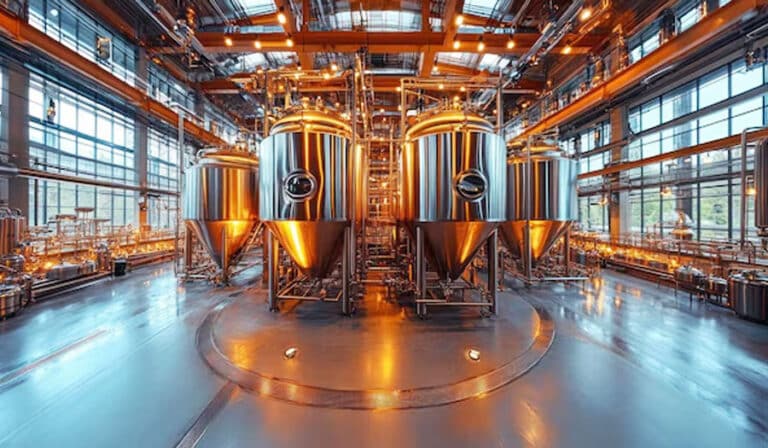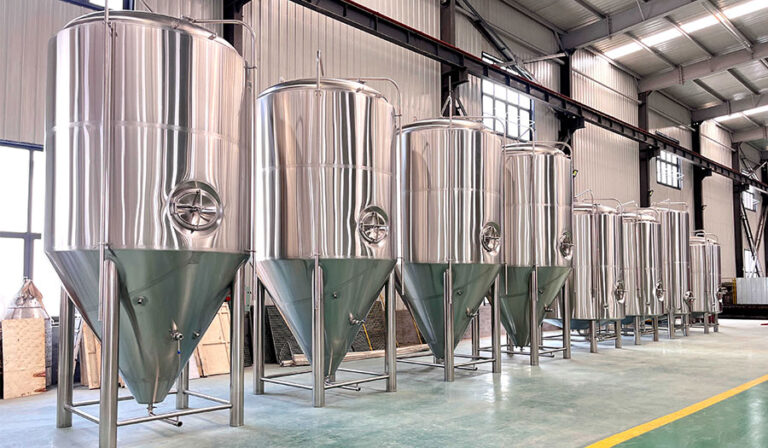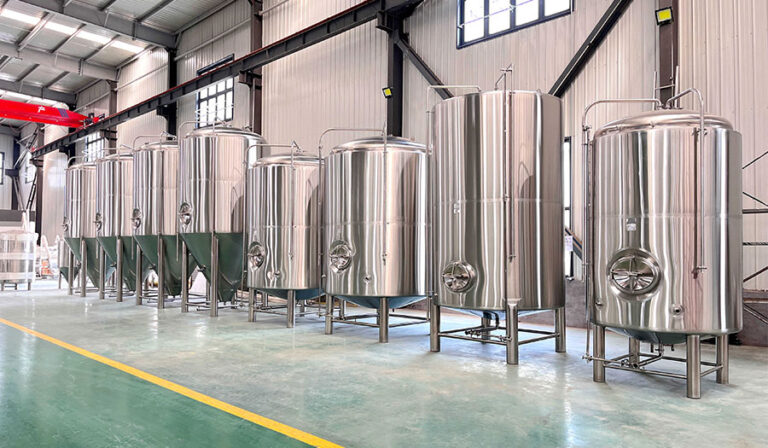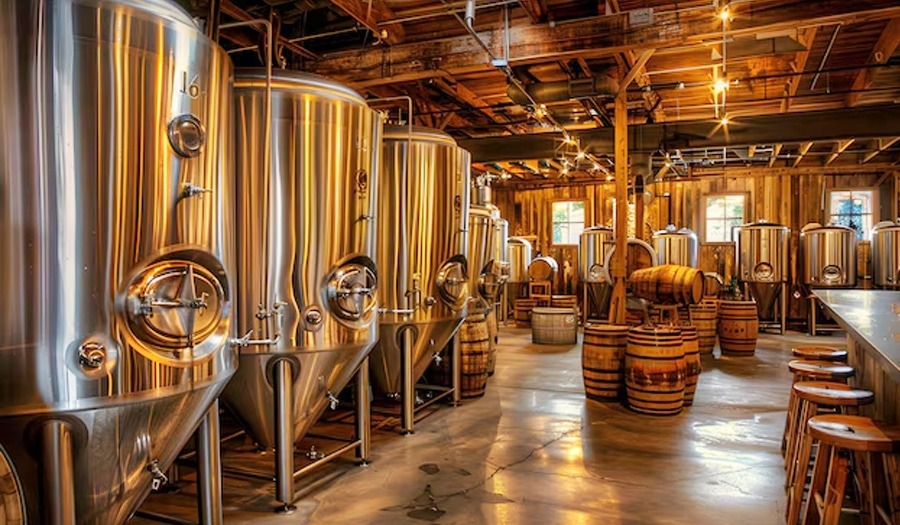Na indústria cervejeira, os tanques de fermentação em aço inoxidável são um dos equipamentos mais importantes. Não só proporcionam um ambiente ideal para promover o processo de fermentação da levedura, mas também garantem o excelente desempenho da cerveja fabricada em termos de sabor, gosto, estabilidade, etc. Este guia explorará a construção, o princípio de funcionamento, a seleção e as precauções de utilização das cubas de fermentação em aço inoxidável, etc., para ajudar os entusiastas da cerveja e os cervejeiros profissionais a compreenderem e utilizarem melhor cubas de fermentação.
A estrutura e o princípio dos tanques de fermentação em aço inoxidável
Cubas de fermentação em aço inoxidável são contentores selados especialmente utilizados para cerveja, vinho, fabrico de cerveja e outros processos. Em comparação com as tradicionais cubas de fermentação de madeira ou vidro, as cubas de fermentação de aço inoxidável tornaram-se uma parte indispensável da moderna tecnologia de fabrico de cerveja devido às suas boas propriedades físicas e químicas.
As cubas de fermentação em aço inoxidável são geralmente compostas pelas seguintes partes:
- Corpo do tanque: O corpo principal do tanque de fermentação, geralmente cilíndrico, com uma certa inclinação ou desenho cónico no fundo para facilitar a descarga de sedimentos.
- Dispositivo de fecho superior: Existem válvulas de entrada e saída de ar na parte superior para garantir a libertação de gás durante a fermentação e evitar a contaminação externa.
- Sistema de controlo da temperatura: Muitos tanques de fermentação em aço inoxidável estão equipados com sistemas de controlo de temperatura para ajustar a temperatura de fermentação e assegurar que a levedura é fermentada a uma temperatura adequada.
- Porta de descarga e porta de amostragem: utilizadas para descarregar os resíduos gerados durante a fermentação e para recolher amostras e detetar o progresso da fermentação.
- Porta de libertação de dióxido de carbono: O dióxido de carbono é um subproduto produzido pela levedura durante a fermentação e é libertado através da porta de exaustão de dióxido de carbono.
- Uma camisa de arrefecimento ou serpentina de arrefecimento: é utilizada para o controlo da temperatura e a temperatura no tanque de fermentação é ajustada através da circulação de água de arrefecimento.

Vantagens do aço inoxidável
Forte resistência à corrosão
A caraterística mais notável do aço inoxidável é a sua excelente resistência à corrosão. Durante o processo de fabrico de cerveja, o líquido de fermentação contém normalmente álcool, substâncias ácidas e dióxido de carbono, que corroem o equipamento. Em comparação com outros materiais (como o vidro ou o plástico), o aço inoxidável pode suportar a corrosão causada pelo ambiente ácido produzido durante o processo de fermentação, o álcool e outras reacções químicas, e não é propenso a ferrugem ou danos. Por conseguinte, a vida útil dos tanques de fermentação em aço inoxidável é muito mais longa do que a dos tanques de fermentação feitos de outros materiais.
Elevada resistência e durabilidade
O aço inoxidável tem uma força mecânica e uma resistência ao desgaste extremamente elevadas e pode suportar um certo grau de impacto e pressão externos. Durante a fermentação, à medida que a atividade da levedura avança, a produção de gás de dióxido de carbono cria pressão no interior do tanque. As cubas de fermentação em aço inoxidável podem suportar de forma estável esta alteração de pressão, assegurando que não ocorrem fugas ou danos durante o processo de fermentação. Além disso, as cubas de fermentação em aço inoxidável não perdem a sua funcionalidade devido ao desgaste ou à corrosão, mesmo após uma utilização prolongada, e têm uma longa vida útil.
Excelente desempenho higiénico
A superfície lisa do aço inoxidável torna-o fácil de limpar e desinfetar, o que é crucial para o processo de vinificação. Ao limpar os fermentadores, a natureza não porosa das superfícies de aço inoxidável assegura que as bactérias ou outros microrganismos têm menos probabilidades de se acumularem, reduzindo assim o risco de contaminação. No processo de vinificação, os requisitos rigorosos para as condições higiénicas significam que a limpeza dos tanques de fermentação deve cumprir padrões extremamente elevados, e o aço inoxidável cumpre este requisito. Por conseguinte, a utilização de cubas de fermentação em aço inoxidável pode efetivamente evitar problemas de fermentação ou uma diminuição da qualidade do vinho causada por uma higiene deficiente.
Bom desempenho no controlo da temperatura
Durante o processo de fermentação, a temperatura tem um impacto importante na atividade da levedura e no efeito da fermentação. Os fermentadores de aço inoxidável facilitam o controlo da temperatura de fermentação através da utilização de um sistema de arrefecimento, como o arrefecimento por camisa ou serpentinas de arrefecimento. A maioria dos tanques de fermentação em aço inoxidável são concebidos com um sistema de controlo de temperatura que pode manter a temperatura do líquido de fermentação dentro do intervalo ideal (normalmente 18-22°C). Esta capacidade de controlo preciso da temperatura ajuda a garantir que a atividade da levedura durante o processo de fabrico da cerveja não é afetada por temperaturas demasiado altas ou demasiado baixas, resultando em sabores de fermentação indesejáveis ou num teor alcoólico instável.
Fortes propriedades antioxidantes
O oxigénio prejudica a qualidade e o sabor das bebidas fermentadas, como a cerveja, e pode causar reacções de oxidação que podem produzir sabor e aroma indesejáveis. As cubas de fermentação em aço inoxidável têm fortes propriedades de vedação, o que pode impedir eficazmente a entrada de oxigénio e reduzir o risco de oxidação. Em contrapartida, as cubas de fermentação de vidro e plástico têm fracas propriedades de vedação, o que pode facilmente permitir a entrada de oxigénio e afetar a qualidade do vinho. A utilização de cubas de fermentação de aço inoxidável pode proteger eficazmente a qualidade do vinho durante o processo de fermentação e garantir que a cerveja final tenha um sabor refrescante e puro.
Fácil de limpar e manter
A superfície lisa do aço inoxidável não só facilita a limpeza como também reduz a aderência de resíduos durante a limpeza. Durante a utilização do depósito de fermentação, pode haver algum açúcar, levedura e resíduos de borras, especialmente no fabrico caseiro de cerveja. Devido à estrutura não porosa do aço inoxidável, estes resíduos não se fixam facilmente na superfície do depósito, reduzindo assim a dificuldade de limpeza. A maioria das cubas de fermentação em aço inoxidável também pode ser limpa utilizando um fluxo de água a alta temperatura ou agentes de limpeza químicos, evitando a dificuldade de limpeza completa das cubas tradicionais de madeira e plástico.
Estabilidade térmica
A superfície lisa do aço inoxidável não só facilita a limpeza como também reduz a aderência de resíduos durante a limpeza. Durante a utilização do depósito de fermentação, pode haver algum açúcar, levedura e resíduos de borras, especialmente no fabrico caseiro de cerveja. Devido à estrutura não porosa do aço inoxidável, estes resíduos não se fixam facilmente na superfície do depósito, reduzindo assim a dificuldade de limpeza. A maioria das cubas de fermentação em aço inoxidável também pode ser limpa utilizando um fluxo de água a alta temperatura ou agentes de limpeza químicos, evitando a dificuldade de limpeza completa das cubas tradicionais de madeira e plástico.
Resistência a altas pressões
Os fermentadores de aço inoxidável são capazes de suportar as altas pressões que podem ocorrer durante a fermentação. Nalgumas produções de cerveja ou de bebidas com elevada pressão de fermentação, os tradicionais tanques de fermentação de plástico ou de vidro podem ficar rachados ou deformados devido à elevada pressão, enquanto os tanques de fermentação de aço inoxidável têm vantagens óbvias a este respeito. Especialmente quando se acumulam gases como o dióxido de carbono, a resistência à alta pressão do aço inoxidável garante a segurança e a fiabilidade do processo de fermentação.
Proteção do ambiente
O aço inoxidável é um material reciclável 100% e tem uma elevada proteção ambiental. Em comparação com outros materiais de utilização única, a escolha de tanques de fermentação em aço inoxidável pode não só reduzir a produção de resíduos, mas também ajudar a reduzir a poluição ambiental. A utilização a longo prazo de tanques de fermentação em aço inoxidável ajuda a reduzir o desperdício de recursos e está em conformidade com os conceitos modernos de proteção ambiental.
Adaptável a vários tipos de fermentação
Os tanques de fermentação em aço inoxidável não são apenas adequados para a produção de cerveja, mas também são amplamente utilizados para a produção de vinho, cidra, vinagre e outras bebidas fermentadas. A sua elevada adaptabilidade permite que este fermentador proporcione condições estáveis durante diferentes tipos de processos de fermentação e satisfaça várias necessidades de vinificação.

Principais considerações ao escolher um fermentador de aço inoxidável
Forte resistência à corrosão
A escolha do fermentador de aço inoxidável correto é crucial para o processo de fabrico da cerveja. Fermentadores de diferentes tamanhos, designs e funções podem afetar a qualidade final da cerveja e a eficiência da produção.
Capacidade
A capacidade do fermentador é uma das considerações mais básicas aquando da escolha. O tamanho do fermentador é normalmente determinado pelo tamanho do lote de fabrico de cerveja. Os cervejeiros caseiros podem necessitar apenas de um fermentador de algumas dezenas de litros, enquanto as cervejeiras comerciais necessitam de grandes fermentadores de centenas a milhares de litros. É muito importante assegurar que o tanque é selecionado de acordo com o volume de fermentação.
Sistema de controlo da temperatura
A temperatura tem uma grande influência na atividade da levedura, pelo que um sistema de controlo de temperatura preciso é muito importante. Alguns fermentadores de aço inoxidável topo de gama estão equipados com um sistema de controlo de temperatura incorporado para manter a temperatura de fermentação dentro do intervalo ideal através de serpentinas de arrefecimento, camisas ou termóstatos. Para a produção de cerveja, a manutenção de uma temperatura constante pode ajudar a levedura a trabalhar em condições adequadas, melhorando assim a qualidade da cerveja.
Design e comodidade
- Fácil de limpar: As superfícies interior e exterior do reservatório devem ser lisas para evitar cantos mortos onde se acumulam resíduos.
- Descarga conveniente de sedimentos: Uma grande quantidade de sedimentos será gerada durante o processo de fermentação, e um fermentador concebido com um fundo cónico pode facilitar a descarga destes sedimentos.
- Porta de exaustão e de recolha de amostras: As válvulas de escape e as portas de amostragem corretamente concebidas permitem aos vinicultores monitorizar a qualidade do vinho em tempo real durante o processo de fermentação.
- Evitar a oxidação: O aço inoxidável ajuda a evitar a oxidação, mas é necessário garantir que o depósito de fermentação tem uma boa vedação para impedir a entrada de ar.
Resistência à corrosão e à pressão
O álcool e o dióxido de carbono produzidos durante o processo de fermentação podem corroer o equipamento, pelo que é muito importante escolher aço inoxidável com forte resistência à corrosão. Além disso, o tanque de fermentação também precisa de ter uma certa resistência à pressão para lidar com as mudanças de pressão durante o processo de fermentação, especialmente a geração de dióxido de carbono.
Utilização e manutenção de cubas de fermentação em aço inoxidável
Precauções durante a utilização
- Monitorização da temperatura: Verificar regularmente a temperatura no tanque de fermentação para garantir que a temperatura está dentro do intervalo ideal para a fermentação da levedura (normalmente 18-22°C).
- Evitar a oxidação: Antes de iniciar a fermentação, certifique-se de que o tanque está bem fechado para evitar a entrada de ar. A presença de oxigénio pode afetar o sabor da cerveja e causar contaminação bacteriana desnecessária.
- Mexer regularmente: Em alguns casos, o vinho pode ser agitado regularmente durante a fermentação para ajudar a levedura a entrar em contacto com o açúcar, mas deve evitar-se uma agitação excessiva para não provocar uma oxidação desnecessária.
- Descarregar os sedimentos após a fermentação: Após a conclusão da fermentação, o sedimento no fundo do tanque de fermentação deve ser descarregado a tempo de evitar afetar a clareza e o sabor da cerveja.

Limpeza e desinfeção
A limpeza e a desinfeção são ligações importantes para manter a utilização a longo prazo das cubas de fermentação em aço inoxidável. Os seguintes passos devem ser seguidos durante a operação:
- Limpeza completa: Não se esqueça de limpar a cuba de fermentação após cada utilização para remover as borras, o açúcar e outros resíduos.
- Utilizar um detergente adequado: Escolher um detergente adequado para aço inoxidável para evitar a corrosão do depósito.
- Desinfeção: Antes e depois de cada utilização, é melhor desinfetar cuidadosamente, especialmente as partes que estão em contacto direto com os materiais de fermentação, como o orifício de alimentação, a válvula de escape, etc.
- Verificar regularmente a vedação: Verificar a vedação do reservatório após cada utilização para evitar fugas de dióxido de carbono durante o processo de fermentação.
FAQ
Porquê escolher cubas de fermentação em aço inoxidável em vez de cubas de plástico ou de vidro?
As maiores vantagens dos tanques de fermentação de aço inoxidável são a sua resistência à corrosão, resistência a altas temperaturas e durabilidade. Comparado com os tanques de fermentação de plástico e vidro, o aço inoxidável pode manter melhor a estabilidade do processo de fermentação e não reagirá quimicamente devido à produção de álcool ou dióxido de carbono. Além disso, o aço inoxidável é mais limpo, reduzindo o risco de contaminação bacteriana.
O que devo fazer se houver um cheiro estranho na cuba de fermentação?
Se houver um cheiro peculiar no tanque de fermentação, verificar primeiro se o corpo do tanque está limpo e se há algum açúcar residual ou material de fermentação. Em segundo lugar, garantir a vedação do corpo do tanque para evitar a entrada de ar ou bactérias. Se o cheiro persistir, pode ter sido contaminado durante o processo de fermentação e o tanque de fermentação precisa de ser cuidadosamente limpo e desinfectado.
Como saber se a fermentação está completa?
O sinal da conclusão da fermentação é normalmente uma redução significativa das emissões de dióxido de carbono na cuba de fermentação, ou a ausência de bolhas. Nesta altura, o enólogo pode recolher amostras para medir a gravidade específica para determinar se o açúcar foi completamente convertido em álcool. Geralmente, após a conclusão da fermentação, a gravidade específica do vinho tende a estabilizar-se.
As cubas de fermentação em aço inoxidável são adequadas para todos os tipos de fabrico de cerveja?
Os tanques de fermentação em aço inoxidável são amplamente utilizados na produção de todos os tipos de cerveja, vinho e outras bebidas fermentadas, especialmente adequados para a produção em massa. Para a produção caseira de cerveja em pequena escala, existem também tanques de fermentação em aço inoxidável de pequena capacidade à escolha. Diferentes tipos de fabrico de cerveja podem exigir diferentes sistemas de controlo de temperatura e designs de tanques, por isso, ao escolher, deve escolher de acordo com os requisitos de fabrico de cerveja.




